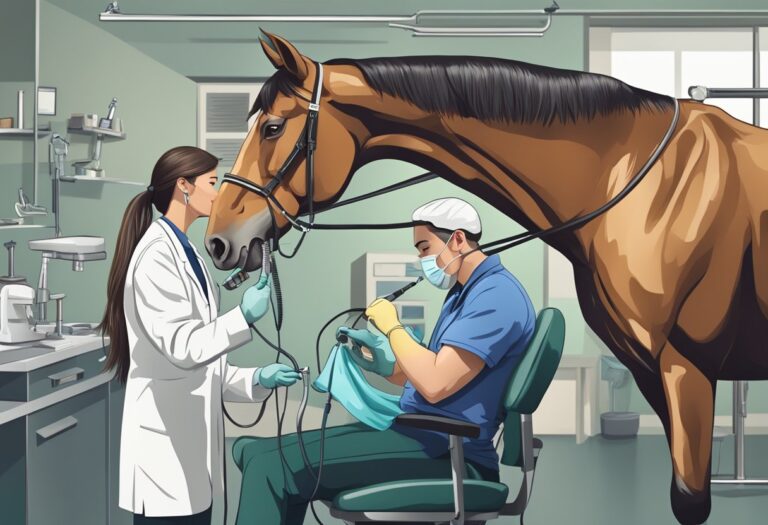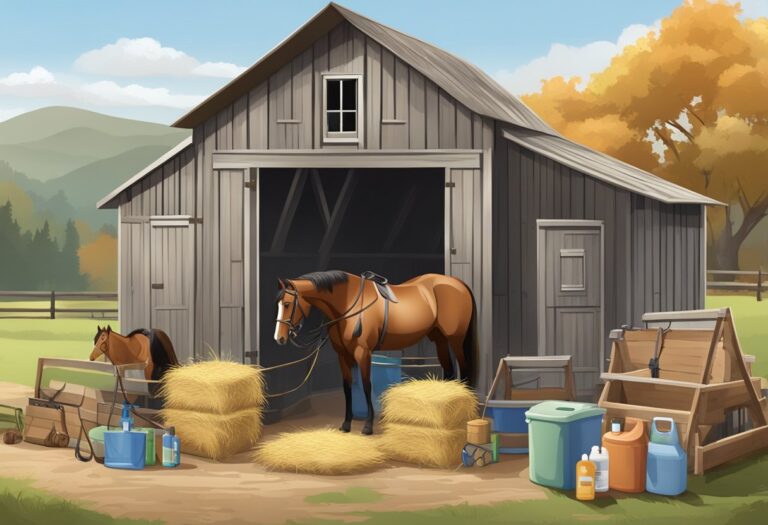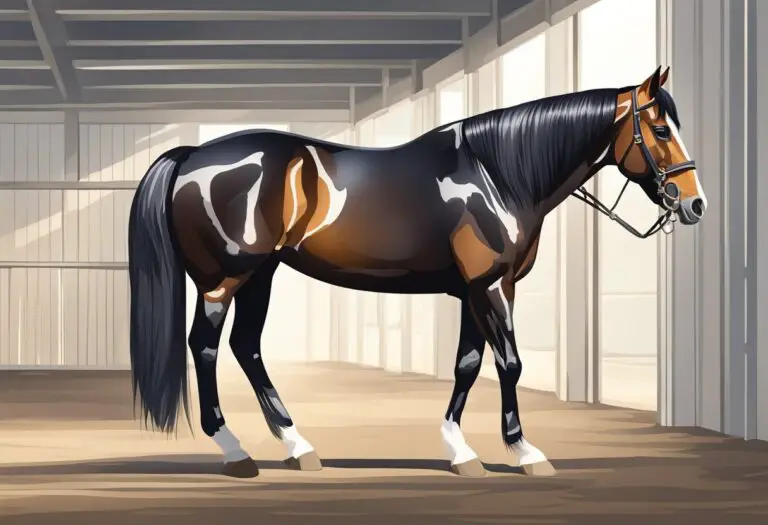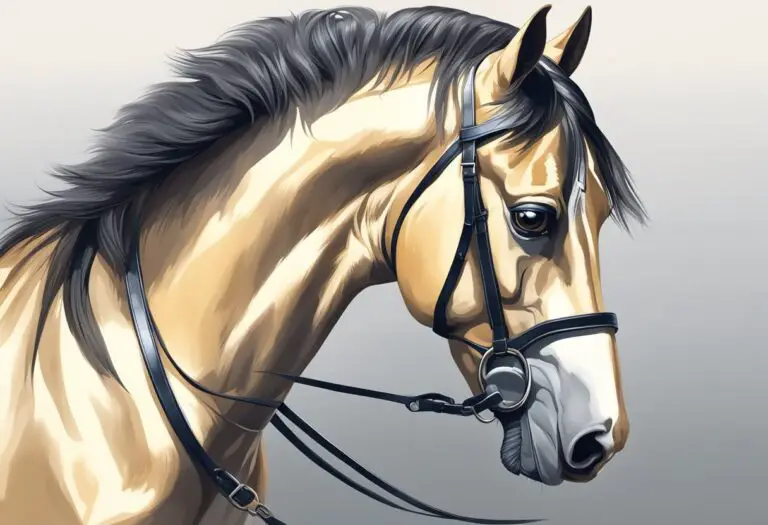How to Groom a Horse? A Step-by-Step Guide
Grooming a horse is an essential part of horse care that involves cleaning, brushing, and maintaining the horse’s coat, mane, tail, and hooves. Proper grooming not only keeps the horse looking clean and healthy but also helps to prevent skin irritations, infections, and other health issues. Grooming a horse can also be a great bonding experience between the horse and the owner.
Before grooming a horse, it’s important to have all the necessary tools and supplies on hand. This includes a hoof pick, soft-bristled brush, curry comb, mane and tail comb, and a sponge or towel for cleaning the horse’s face. It’s also important to have a safe and secure area to groom the horse, such as a grooming stall or cross-ties. Once all the supplies are gathered, the horse should be tied or held securely and the grooming can begin.
Preparing for Grooming

Gather Necessary Tools
Before beginning to groom a horse, it is important to gather all the necessary tools. This will help ensure that the grooming process is efficient and effective. Some of the essential tools for grooming a horse include:
- Curry comb
- Dandy brush
- Body brush
- Mane comb
- Hoof pick
- Towel
- Grooming spray (optional)
It is important to ensure that all tools are clean and in good condition before beginning to groom the horse. This will help prevent any injuries to the horse and ensure that the grooming process is comfortable for the horse.
Secure the Horse
Once all the necessary tools have been gathered, the next step is to secure the horse. This can be done by tying the horse to a sturdy post or using cross-ties. It is important to ensure that the horse is comfortable and secure before beginning to groom.
If the horse is tied to a post, it is important to ensure that the lead rope is not too tight and that the horse has enough room to move around comfortably. If cross-ties are used, it is important to ensure that they are properly adjusted and that the horse is not able to pull back and injure itself.
In conclusion, preparing for grooming is an important step in ensuring that the grooming process is efficient and effective. Gathering all the necessary tools and securing the horse are essential steps that should not be overlooked.
Basic Grooming Techniques

Brushing the Coat
Brushing the coat is an essential part of grooming a horse. It not only removes dirt and debris but also helps to distribute natural oils throughout the coat, which keeps it healthy and shiny. Start by using a curry comb in a circular motion to loosen dirt and dead skin. Then, use a stiff-bristled brush to remove the dirt and debris from the coat. Finally, use a soft-bristled brush to smooth the coat and give it a polished look.
Cleaning the Hooves
Cleaning the hooves is another important aspect of grooming a horse. Neglecting to clean the hooves can lead to infections and other health issues. Begin by using a hoof pick to remove any debris that may have accumulated in the hoof. Then, use a stiff-bristled brush to clean the hoof wall and sole. Make sure to check for any signs of thrush or other infections, and consult a veterinarian if necessary.
Combing Mane and Tail
Combing the mane and tail is the final step in basic grooming techniques. Use a wide-toothed comb to work out any tangles or knots in the mane and tail. For particularly stubborn tangles, use a detangler spray or conditioner to help loosen the hair. Be gentle when combing to avoid breaking or damaging the hair.
Remember, grooming a horse is not only important for their appearance but also for their health and well-being. By following these basic grooming techniques, you can help keep your horse healthy and happy.
Advanced Grooming

Trimming Mane and Tail
Trimming the mane and tail of a horse is an essential part of advanced grooming. It helps to keep the horse’s appearance neat and tidy and also prevents tangling and matting of the hair. To trim the mane and tail, use a pair of sharp scissors or clippers. It is important to be precise and careful when trimming, as any mistakes can be difficult to fix.
When trimming the mane, start at the top and work your way down. Use a comb to separate the hair and trim any excess length, making sure to create a straight line. For the tail, start at the bottom and work your way up. Use a comb to separate the hair and trim any excess length, making sure to create a straight line. Be careful not to cut the tail too short, as this can cause discomfort to the horse.
Clipping Excess Hair
Clipping excess hair is another important part of advanced grooming. It helps to keep the horse’s coat looking neat and tidy and also prevents overheating during exercise. To clip excess hair, use a pair of clippers with a sharp blade. It is important to be careful when clipping, as any mistakes can be difficult to fix.
When clipping, start at the top and work your way down. Use a comb to separate the hair and clip any excess length, making sure to create a smooth and even finish. For areas such as the legs and face, use a smaller set of clippers or scissors to ensure precision and accuracy. Be sure to clean the clippers regularly to maintain their performance and prevent any discomfort to the horse.
Bathing the Horse

Bathing a horse is an important part of grooming, as it helps to keep the coat clean and healthy. Here are the steps to follow when bathing a horse:
Wetting the Horse
Before applying any shampoo, the horse needs to be wetted down thoroughly. This can be done using a hose or buckets of water. It’s important to make sure that the water is not too hot or too cold, as this can be uncomfortable for the horse. Begin by wetting the horse’s legs, then move up to the body, and finally the head and neck. Be careful not to get water in the horse’s ears or eyes.
Shampooing
Once the horse is wet, it’s time to apply shampoo. Use a shampoo specifically designed for horses, as human shampoo can be too harsh and cause skin irritation. Apply the shampoo to a sponge or soft brush, and work it into the horse’s coat in a circular motion. Pay special attention to areas that tend to get dirty, such as the mane, tail, and legs. Avoid getting shampoo in the horse’s eyes or ears.
Rinsing and Drying
After the shampoo has been applied, it’s time to rinse the horse off. Use a hose or buckets of water to thoroughly rinse the shampoo out of the horse’s coat. Be sure to rinse all areas of the horse, including under the belly and between the legs. Once the horse is rinsed, use a sweat scraper to remove excess water from the coat. Then, use a towel or cooler to dry the horse off completely. It’s important to make sure that the horse is completely dry, as a wet coat can lead to skin irritation and other health problems.
By following these steps, you can ensure that your horse is clean and healthy. Regular bathing is an important part of horse grooming, and can help to keep your horse looking and feeling great.
Grooming for Health

Regular grooming is essential for the overall health and well-being of your horse. Grooming not only keeps your horse looking good, but it also helps to prevent health problems. In this section, we will discuss how to groom your horse for optimal health.
Checking for Injuries
One of the most important aspects of grooming your horse is checking for injuries. This is especially important if your horse spends a lot of time in the pasture or is used for riding. Look for any cuts, scrapes, or swelling on your horse’s body. If you notice any injuries, clean them with an antiseptic solution and apply a bandage if necessary.
Looking for Parasites
Parasites can cause a variety of health problems in horses, including weight loss, anemia, and colic. Regular grooming can help to prevent parasite infestations. Look for any signs of parasites, such as lice or ticks. If you notice any, speak to your veterinarian about the best course of treatment.
Monitoring Hoof Health
Hoof health is crucial for your horse’s overall well-being. Regular grooming can help to prevent hoof problems such as thrush or abscesses. Check your horse’s hooves regularly for any signs of cracking, splitting, or infection. If you notice any problems, speak to your farrier about the best course of action.
By following these grooming tips, you can help to keep your horse healthy and happy. Regular grooming not only helps to prevent health problems, but it also strengthens the bond between you and your horse.
Post-Grooming Care

After grooming your horse, it is important to take care of them properly. This includes cooling them down and rewarding them for their good behavior.
Cooling Down the Horse
After grooming, the horse’s body temperature may be slightly elevated. To cool them down, you can walk them around for a few minutes or hose them down with cool water. Be sure to scrape off any excess water to prevent them from getting chilled.
Rewarding the Horse
It is important to reward your horse for standing still and cooperating during the grooming process. This can be done with a treat or a scratch on their favorite spot. It is also important to give them some time to relax and graze before putting them back in their stall or pasture.
By following these post-grooming care tips, you can help keep your horse healthy and happy.







